Muscularis externa Study guides, Class notes & Summaries
Looking for the best study guides, study notes and summaries about Muscularis externa? On this page you'll find 193 study documents about Muscularis externa.
Page 4 out of 193 results
Sort by
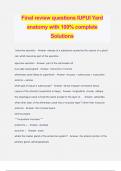
-
Final review questions IUPUI Yard anatomy with 100% complete Solutions
- Exam (elaborations) • 4 pages • 2024
- Available in package deal
-
- $10.49
- + learn more
Final review questions IUPUI Yard anatomy with 100% complete Solutions holocrine secretion - Answer- release of a substance caused by the rupture of a gland cell, which becomes part of the secretion apocrine secretion - Answer- part of the cell breaks off true salty sweat gland - Answer- merocrine or eccrine alimentary canal (deep to superficial) - Answer- mucosa > submucosa > muscularis externa > serosa what type of tissue is submucosa? - Answer- dense irregular connective tis...
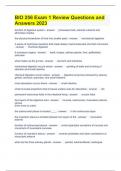
-
BIO 256 Exam 1 Review Questions and Answers 2023
- Exam (elaborations) • 5 pages • 2023
- Available in package deal
-
- $18.49
- + learn more
BIO 256 Exam 1 Review Questions and Answers 2023 function of digestive system processes food, extracts nutrients and eliminates residue the physical breakdown of food into smaller parts mechanical digestion A series of hydrolysis reactions that break dietary macromolecules into their monomers chemical digestion 6 accessory organs teeth, tongue, salivary glands, liver, gallbladder, pancreas what makes up the gi tract stomach and intestines mechanical diges...
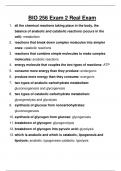
-
BIO 256 Exam 2 Real Exam 2023
- Exam (elaborations) • 7 pages • 2023
-
- $11.49
- + learn more
BIO 256 EXAM 1 Real Exam 1. The salivary enzyme amylase functions to break down.: Carbohydrates 2. Peristalsis occurs in the digestive tract: from the pharynx to the anus 3. The ________________ serves as a valve that controls the movement of food between the esophagus and the stomach.: lower esophageal sphincter (also gastroesophageal or cardiac sphincter) 4. The membrane that binds the small intestines to the abdominal wall is called?: Mesentery 5. The accessory organs of the...
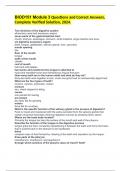
-
BIOD151 Module 3 Questions and Correct Answers, Complete Verified Solution, 2024.
- Exam (elaborations) • 5 pages • 2024
-
- $10.98
- + learn more
BIOD151 Module 3 Questions and Correct Answers, Complete Verified Solution, 2024. Two divisions of the digestive system alimentary canal and accessory organs seven parts of the gastrointestinal tract mouth, pharynx, esophagus, stomach, small intestine, large intestine and anus six digestive accessory organs teeth, tongue, gallbladder, salivary glands, liver, pancreas mouth opening lips floor of the mouth tongue walls of the mouth cheeks roof of mouth hard and soft palates two bo...
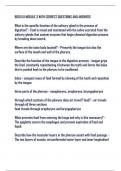
-
BIOD 151 MODULE 3 WITH CORRECT QUESTIONS AND ANSWERS
- Exam (elaborations) • 10 pages • 2024
-
- $20.99
- + learn more
BIOD 151 MODULE 3 WITH CORRECT QUESTIONS AND ANSWERS What is the specific function of the salivary gland in the process of digestion? - Food is mixed and moistened with the saliva secreted from the salivary glands that contain enzymes that begin chemical digestion process by breaking down starch. Where are the taste buds located? - Primarily the tongue but also the surface of the mouth and wall of the pharynx. Describe the function of the tongue in the digestive process - tongue gri...
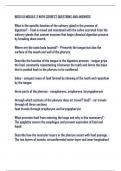
-
BIOD 151 MODULE 3 WITH CORRECT QUESTIONS AND ANSWERS
- Exam (elaborations) • 10 pages • 2024
-
- $20.89
- + learn more
BIOD 151 MODULE 3 WITH CORRECT QUESTIONS AND ANSWERS What is the specific function of the salivary gland in the process of digestion? - Food is mixed and moistened with the saliva secreted from the salivary glands that contain enzymes that begin chemical digestion process by breaking down starch. Where are the taste buds located? - Primarily the tongue but also the surface of the mouth and wall of the pharynx. Describe the function of the tongue in the digestive process - tongue gri...
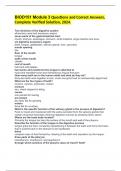
-
BIOD151 Module 3 Questions and Correct Answers, Complete Verified Solution, 2024.
- Exam (elaborations) • 5 pages • 2024
-
- $10.88
- + learn more
BIOD151 Module 3 Questions and Correct Answers, Complete Verified Solution, 2024. Two divisions of the digestive system alimentary canal and accessory organs seven parts of the gastrointestinal tract mouth, pharynx, esophagus, stomach, small intestine, large intestine and anus six digestive accessory organs teeth, tongue, gallbladder, salivary glands, liver, pancreas mouth opening lips floor of the mouth tongue walls of the mouth cheeks roof of mouth hard and soft palates two bo...
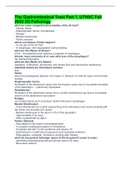
-
The Gastrointestinal Tract Part 1, UTHSC Fall 2022 D2 Pathology (Answered)
- Exam (elaborations) • 7 pages • 2023
-
- $11.19
- + learn more
The Gastrointestinal Tract Part 1, UTHSC Fall 2022 D2 Pathology what are some congenital abnormalities of the GI tract? - Atresia, fistula - Diaphragmatic hernia, omphalocele - Ectopia - Meckel diverticulum - Pyloric stenosis where can Atresia, Fistula happen? - In any part of the GI tract - In esophagus, with regurgitation during feeding what are the effects of atresia? a thin , noncanalized cord replaces a segment of esophagus Atresia, most commonly at or near what area of the esop...
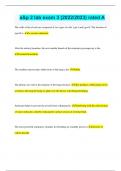
-
a&p 2 lab exam 3 (2022/2023) rated A
- Exam (elaborations) • 8 pages • 2023
- Available in package deal
-
- $9.99
- + learn more
a&p 2 lab exam 3 (2022/2023) rated A The walls of the alveoli are composed of two types of cells, type I and type II. The function of type II is: to secrete surfactant. After the tertiary bronchus, the next smaller branch of the respiratory passageway is the: terminal bronchiole. The smallest macroscopic subdivision of the lung is the: lobule. The pleurae are vital to the integrity of the lungs because: they produce a lubricating serous secretion, allowing the lungs to glide over the thorax ...
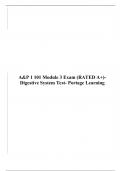
-
A&P 1 101 Module 3 Exam (RATED A+)-Digestive System Test- Portage Learning
- Exam (elaborations) • 14 pages • 2023
- Available in package deal
-
- $13.00
- + learn more
A&P 1 101 Module 3 Exam-Digestive System Test Question 1 5 / 5 pts Explain why a patient with liver disease would have intolerance to fatty foods. Your Answer: Because one of the function of t he liver is to produce bile. Bile is used to emulsify fat, if the fat cannot be broken down, the patient will have intolerance with fatty foods. The liver produces bile which breaks down fats. If it is not producing bile (or less bile), fats will not be broken down effectively. Question 2 5 / 5 pts Explain...

How did he do that? By selling his study resources on Stuvia. Try it yourself! Discover all about earning on Stuvia


